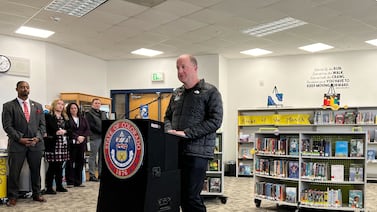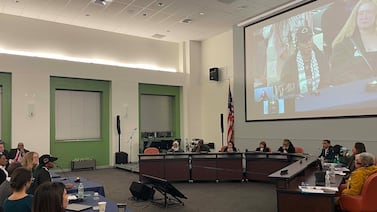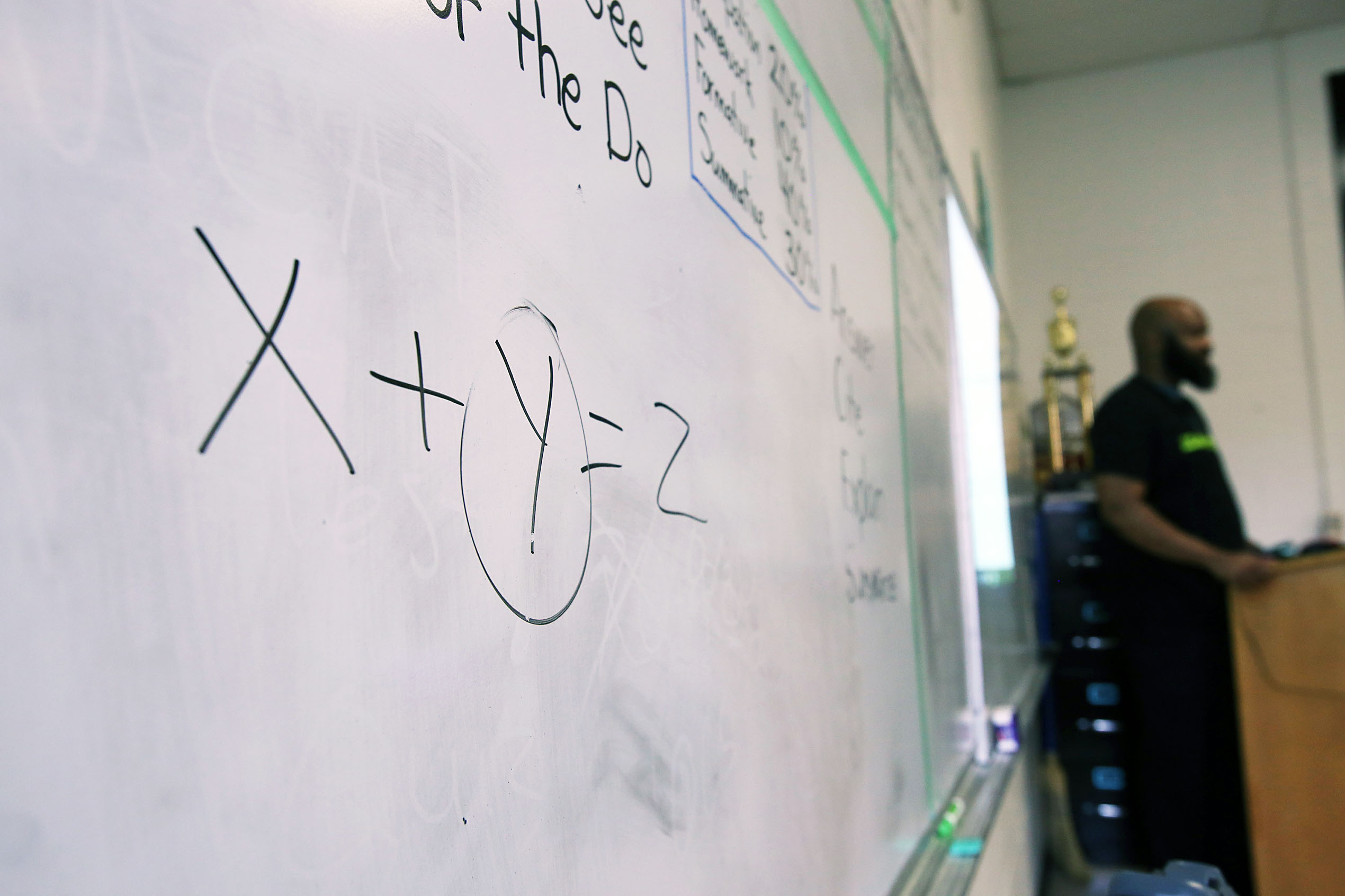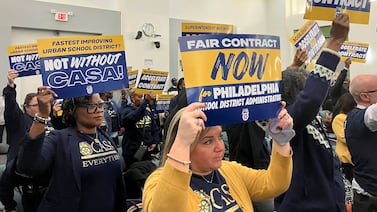Sign up for Chalkbeat Colorado’s free daily newsletter to get the latest reporting from us, plus curated news from other Colorado outlets, delivered to your inbox.
More than 30 of Colorado’s 178 school districts are asking voters to approve a local tax measure in this November’s election.
The number of requests on the ballot isn’t more than in some past years. But what has gone up is the amount of money districts are requesting — nearly $7 billion.
There are two types of tax measures districts are putting to voters this year. Bond and capital measures would mostly go to pay for new school buildings, renovations, new air conditioning in some districts, and safety upgrades. Mill levy overrides would raise operating dollars that would mostly help increase staff pay and add more career education opportunities for students.
Some districts are planning to use the money for unique needs. Adams 12 would like to build a central warehouse and kitchen. Harrison would like to continue a scholarship program for graduates. And Weld County’s 3J district would like to hire more bus drivers.
While some Colorado homeowners have already seen higher property tax bills this year, when it comes to education, those increases don’t always translate to more money for schools.
The state uses a formula to calculate how much funding each district needs per student. When local property tax revenues aren’t enough to reach that amount, the state pitches in funding. In many districts, rising property tax revenue has simply allowed the state not to have to fill in as much with its own dollars, but the total dollars per student hasn’t changed.
If approved, bond and mill levy override dollars are provided to school districts in addition to the amount of money that the state calculates districts must have per student.
Some districts that pass tax measures and have high property wealth in their communities gain an advantage over other districts that aren’t able to pass these tax measures for additional funds. This year, a couple of the districts requesting a mill levy override for operating dollars on top of their state calculation, Pueblo 70 and Montezuma, have never passed such a tax measure before.
The Harrison and Adams 14 school districts last passed mill levy overrides more than 20 years ago.
Below is some more information about proposed tax measures in several districts.
Harrison hopes to keep funding community college scholarships
- $9 million mill levy override request for teacher salaries and the district’s scholarship program for graduates.
- If approved it will cost homeowners about $5.31 per month per $100,000 of a home’s value.
Wendy Birhanzel, the superintendent for the Harrison school district in Colorado Springs, said that about 100 students have already benefited from the district’s scholarship program, which allows district graduates to attend two years of community college for free.
She said for many of the district’s students who didn’t think higher education was possible, being able to go to college is a “game changer” that can alter the trajectory of their lives.
And during the beginning of the pandemic, when college-going rates were going down elsewhere, Birhanzel said the rate kept going up in Harrison.
But the scholarship program was privately funded for the three years. District leaders said they hope voters will approve the mill levy override in order to continue it.
In addition to the scholarship program, Birhanzel said the district needs more money to be able to increase teacher pay.
“Our retention and hiring is better than surrounding districts,” Birhanzel said. But to be able to keep competing, and increasing salaries, the new money would go a long way: “We want to have that competitive advantage.”
Aurora’s request won’t require a higher tax rate
- $1 billion bond request for three new school buildings and other renovations.
- $30 million capital funds mill levy for some ongoing maintenance, salaries, and career education.
- If approved, the tax rate homeowners pay will stay the same.
In Aurora, the district’s chief financial officer Brett Johnson, says the district’s ability to plan ahead for the past few years has allowed them to make more debt payments.
For the past few years, with previous debt, the district has paid about $80 million per year in principal and interest. But with accelerating payments, those annual payments will go down by $50 million, allowing the district capacity to now take out $1 billion in bonds with the same amount in payments, meaning no additional taxes will be necessary, Johnson said.
The district has a need for such a large amount of funding in part due to how much buildings cost now.
The Aurora district has seen a decline of students on its western boundary near Denver as housing costs rise. But on the opposite boundary, opening up to the eastern plains, the district is rapidly growing and needs new schools for the new homes being built.
“We’re talking as many as 2,000 new homes per year at this point,” Johnson said.
The district has already opened new schools in recent years with previous bonds, but this year’s request would pay for two more pre-K-8 buildings and a high school.
In 2016, with the last bond, a pre-K-8 building cost the district between $30 million and $35 million. Now, a similar building will cost $80 million.
The new high school building is expected to cost between $220 million and $230 million, up from around $100 million in 2016. The Cherry Creek school district, next to Aurora, is also requesting a bond to build a new high school, and has estimated a similar cost.
Aurora’s second request, a capital mill levy, is a request for ongoing capital funds that are expected to generate about $30 million annually, and also will not need a higher tax rate.
If that measure passes, Johnson said that ideally the district would do more maintenance, such as upgrading HVAC systems, on a routine basis, rather than waiting to pass bonds.
Adams 12 says it needs new Thornton High School
- $830 million bond request for a new high school, new central kitchen, and other maintenance.
- $34.5 mill levy override request for teacher salaries, computer science classes, and career education.
- If approved, the bond will not require a tax increase. The mill levy override would cost homeowners about $2.04 per month per $100,000 in home value.
Thornton High School isn’t the oldest building in the Adams 12 school district, but it’s the one that’s causing the most problems. The school was built on a hillside, and has up to five floors on one part of the building. There are ramps throughout the building, but some parts are still a challenge for ensuring accessibility under the Americans with Disabilities Act.
There have been other problems too, ranging from water pressure to masonry issues that endangered the structure.
Adams 12 is now planning to construct a new building for Thornton High on the same campus.
Chris Gdowski, the Adams 12 superintendent, said that the district has invested more in buildings in the north of the district. With the new Thornton High, the district is looking to bring more needed investments to the older part of the district.
The bond would also pay to expand air conditioning to more parts of school buildings, such as gymnasiums and cafeterias, while also upgrading the filtration systems to improve air quality.
The district would also build a new central kitchen and warehouse that will allow the district to cook more meals for students, decreasing the reliance on pre-packaged meals.
Gdwoski said without a large enough storage site, Adams 12 has to ask for multiple deliveries so the orders are taken to each school. Instead, the district wants large orders to come to a central location where staff can prepare meals and then deliver them to school sites.
“It’s about double the cost now compared to what it will be” if the measure is approved, Gdowski said.
Additionally, with the mill levy override, the district wants to expand a pilot program for how it pays teachers. This year, the pilot is at two schools, and if the tax measure is approved, it would expand to all other Title I schools in the district over the next two years.
All teachers would also get a 2% raise for the current year.
Westminster’s big focus is expanding career education
- $111 million bond request for expanding career education, and for security, and air conditioning upgrades to schools.
- If approved it would not cost any additional in property taxes
This fall, the district opened a new building, the Iver C. Ranum Innovation Campus, where high school students can take career classes that will earn college credit as well as industry certificates. Westminster wants to do more of the same through bond money.
“It really comes down to making sure we are providing for the needs of our students for the jobs of the 21st century in Adams County,” said Jeni Gotto, Westminster’s new superintendent.
The building also hosts younger students to help them explore what they want to do when they grow up. Next fall, the school will also partner with Front Range Community College to offer career education for adult students.
If the bond is approved, Wesntminster plans to expand the career offerings based on family surveys and a consultant that helped evaluate the career pathways. Among the planned programs are an expansion of the biomedical courses and offerings, as well as advanced manufacturing, construction engineering, and culinary arts.
Westminster’s bond would also help add air conditioning to the remaining schools that don’t yet have it, as well as security upgrades at schools too.
Yesenia Robles is a reporter for Chalkbeat Colorado covering K-12 school districts and multilingual education. Contact Yesenia at yrobles@chalkbeat.org.







